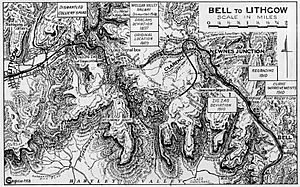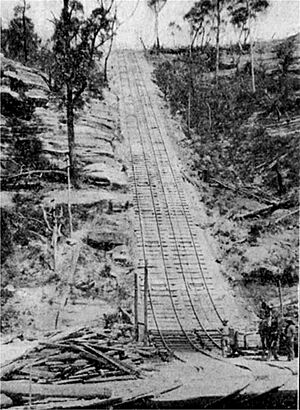Ten Tunnels Deviation facts for kids
 |
|
| A 1958 map of the Lithgow Zig Zag and deviation | |
| Overview | |
|---|---|
| Line | Main Western |
| Location | Lithgow, New South Wales |
| Coordinates | 33°29′33″S 150°13′06″E / 33.4925858296°S 150.2184178820°E |
| Status | Operating |
| Start | Newnes Junction station |
| End | Zig Zag station |
| Operation | |
| Work begun | 1 June 1908 |
| Owner | Transport Asset Holding Entity |
| Operator | NSW TrainLink |
| Technical | |
| Length | Ten tunnels of varying length from 70 to 825 metres (230 to 2,707 ft) |
| Line length | 9.2 kilometres (5.7 mi) |
| No. of tracks | 2 |
| Gauge | 1,435 mm (4 ft 8 1⁄2 in) standard gauge |
| Electrified | 1957 |
| Grade | 1:90 |
The Ten Tunnels Deviation is a special 9.2-kilometre (5.7 mi) section of the Main Western Line in New South Wales, Australia. It runs between Newnes Junction and Zig Zag stations near Lithgow. This railway section was built by the New South Wales Government Railways between 1908 and 1910.
This important railway section is also known as the Great Zig Zag Railway deviation tunnels or the Bell to Zig Zag Ten Tunnel Railway Deviation. It was added to the New South Wales State Heritage Register in 1999 because of its historical value.
When the tunnels opened in 1910, they replaced an older, winding railway section called the Lithgow Zig Zag. The old Zig Zag made trains go very slowly and limited how long they could be. The new deviation has ten tunnels of different lengths, from 70 to 825 metres (230 to 2,707 ft). It also included a very deep 61-metre (200 ft) cutting, which was the deepest on the NSW rail system at the time. Thanks to these changes, train journeys became 20 to 30 minutes faster.
Contents
History of the Railway
Early Railway Challenges
The first Main Western railway line, built in 1869, went north from Mount Victoria. It then turned west into the Dargan's Creek valley. To get down to the valley floor, the railway used a special design called the Zig Zag. This meant the track switched back on itself twice. From there, it continued west to Lithgow. This part of the line opened in October 1869.
The 1869 Zig Zag section soon became a problem because it slowed down trains. By 1885, people were already thinking about replacing it. In 1897, the first big change was made. This was called Dargan's Creek Deviation. It moved the railway to the northern side of the creek. However, this part was still a single track, which caused more delays. To fix this, extra passing loops were added in 1901 and 1902.
Building the New Route
In 1906, a new station and junction were built at Newnes Junction. This junction connected to a private railway line called the Newnes railway line. By 1910, it was clear that a completely new route was needed to get trains down to Lithgow more easily.
So, the new route, known as the Ten Tunnels Deviation, was built. The old Dargan's Creek Deviation was then closed. Some stations were moved or closed. Newnes Junction was moved closer to Sydney, and a new Clarence station was built. The Newnes Line closed in 1932 after 25 years.
The Ten Tunnels Deviation started at Newnes Junction and ended at Bottom Points (now called Zig Zag platform). As its name suggests, it had 10 new tunnels. This new route avoided the old Zig Zag. It followed the previous line for a while, then turned south. It took a longer path through the tunnels, coming out near the bottom of the old Zig Zag.
During construction, a special funicular railway helped bring supplies down. This funicular dropped 107 metres (350 ft) from the ridge. Up to 1500 workers were on the project every day.
Benefits of the Deviation
The Ten Tunnels Deviation was part of a bigger project to make the Main Western Railway a double track between Penrith and Lithgow. When finished, the deviation had ten tunnels of different lengths. The longest was about 825 metres (902 yd). It also included the deepest railway cutting in NSW, which was 61 metres (200 ft) deep.
These improvements cut journey times by 20 to 30 minutes. Also, the slope of the track was made much gentler, from 1 in 42 to 1 in 90. This meant trains could carry twice as much weight.
In 1972, a group of railway fans started the Zig Zag Cooperative. They took over the old track between the original Clarence station and Bottom Points. Today, the Zig Zag Railway is a popular tourist attraction. A new platform, Zig Zag, was built on the Main Western line so people could easily visit the tourist railway.
How It Was Built

The plan to build the double-line deviation was approved in December 1906. Construction began near the former Oakey Park Colliery. The railway passed Bottom Points and then went into a series of ten tunnels. Originally, eleven tunnels were planned. However, one was opened up into a cutting because of rock problems. This created the deepest cutting on the NSW rail system.
The main base for the construction was at Clarence. Many of the workers, called navvies, lived there temporarily. A temporary power station was set up in Clarence to power rock drills and lights.
Getting to the tunnel sites was very difficult. At one point, horses and carts had to be lowered onto the worksite using a crane. They stayed there until the tunnels were finished, providing a way out. For tunnels 8, 9, and 10, a 110-metre (350 ft) funicular railway helped bring materials. Only experienced miners worked on the dangerous tunnelling jobs, day and night. About 1,500 people worked on the project each day.
The tunnels were built on a gentle slope of 1 in 90. The line curves towards Newnes Junction after leaving the tunnels. Newnes Junction station also had to be moved 660 metres (2,170 ft) to its current spot. Two more tracks were built for the Commonwealth Oil Corporation's Newnes railway line. After the deviation was finished, much of the equipment and many workers moved to another railway project, the deviation of the Lapstone Zig Zag. This caused the population of Clarence to drop quickly.
The Ten Tunnels Deviation was electrified in 1957, along with the rest of the line. In 1978, the track bed inside the tunnels was lowered. This allowed taller double-deck V sets trains to use the line. More changes were planned in 2018 to fit even newer trains, the D sets.
What the Tunnels Look Like
The deviation includes ten tunnels of different lengths. They range from 70 to 825 metres (77 to 902 yd) long. These tunnels carry the double-track 1,435 mm (4 ft 8 1⁄2 in) standard gauge Main Western line. The deepest cutting in the NSW rail system, 61 metres (200 ft) deep, is also part of this section. The tunnels are numbered starting from the Sydney end.
The entrances to the tunnels are oval-shaped. Concrete was used for the floor and lower walls, and brickwork was used for the arches. The tunnels are built mainly from brick.
Current Condition
As of 2010, the tunnels were generally in good condition. A report from 2007 noted a few minor issues:
- Some water was seeping in tunnels 1, 3, and 4.
- Tunnel 6 had small cracks at the Sydney end.
- Tunnel 9 had small cracks and water stains.
- Tunnel 10 had water seeping from the top.
Overall, the Ten Tunnel Deviation is still complete and in good shape.
Changes Over Time
- 1952: Land was bought for another railway change near Lithgow. However, when the line was electrified in 1957, this change was no longer needed.
- 1978: The traditional wooden sleepers in the tunnels were replaced with a continuous concrete bed. This was updated again in 2002-2003.
Why It's Important
The Ten Tunnel Deviation is very important to the history of New South Wales. It represents the second major way the railway crossed the Great Dividing Range. It is also a great example of engineering from the early 1900s. The project included digging the deepest cutting on the NSW rail system.
This project was one of the most important railway changes built in NSW. It successfully made train journeys faster and reduced the steepness of the track. It is still used today. The tunnels are part of a larger railway history in the Lithgow and Blue Mountains area. This includes the Zig Zag railway and other old railway sites.
The Ten Tunnels Deviation was listed on the New South Wales State Heritage Register in 1999 for several reasons:
- Historical Significance: It shows an important part of railway history in New South Wales. It was a major project that is still in use.
- Technical Achievement: It shows high-level engineering skills for building tunnels and railways. The project involved many workers and led to faster journeys and trains carrying more weight.
- Research Potential: It can teach us about how tunnels were built in the early 1900s.
- Rarity: It is a rare and major engineering achievement from the early 1900s.
- Representation: It is a good example of brick-arch tunnel construction used for railway changes in NSW during that time.

